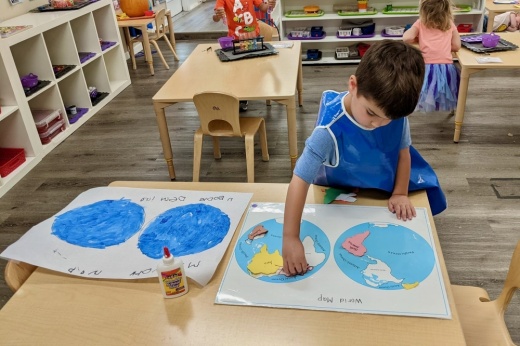According to a July report issued by research and advocacy nonprofit Children at Risk—a third of all ZIP codes in Texas qualify as “child care deserts,” meaning there are at least three times more children eligible for early child care than the number of child care seats available.
Since 2020, Texas child care providers have received more than $4 billion in federal relief funds, including roughly $2.45 billion through the federal American Rescue Plan Act approved in 2021. However, the relief funds expired in September.
Some local providers operating at prepandemic capacity said wait times to secure a seat could be affected by the loss of funding. However, other providers, particularly in low-income areas, said the loss of funding coupled with low re-enrollment rates could cause their businesses to close.
The overview
In the Greater Houston area, 45 ZIP codes qualify as child care deserts, according to data provided by Children at Risk.
To determine child care deserts, Children at Risk officials used 2022 U.S. Census Bureau data to define a child as eligible for care if they were age 5 or younger and both of their parents were employed. In the Spring and Klein area as defined by Children at Risk, three ZIP codes qualify as child care deserts: 77066, 77069 and 77382.Kim Kofron, Children at Risk’s senior director of education, said she believes access to child care has been a problem statewide for decades, but noted the issue was further complicated by the pandemic.
Kofron said Texas had around 17,000 early child care centers before the pandemic hit in 2020. While that number had fallen to roughly 12,000 in 2021, she said the number of providers has since rebounded to around 14,000.
Despite the increase, Kofron said more than 70,000 kids throughout the state are currently on waitlists to receive early child care.
Matt Evers—co-owner of several Primrose locations in the Greater Houston area, including Primrose School at Crossroads Park in Cypress—said parents should apply at least six months in advance, noting wait times can increase to as much as two years for infants.
However, Denise Statlander, owner of Greengate Academy in Spring, said her business has about half as many students enrolled following the pandemic, noting the drop in enrollment is threatening the day care’s ability to survive.
What they're saying
- “The gap between the low income and the upper income is greater and greater here. ... The day cares in the lower-income areas can’t afford to stay in business. The Primrose [schools] have au pairs and things like this. They can survive, and they have [student] waiting lists.” —Denise Statlander, owner, Greengate Academy
- “Those statistics show that there’s not enough space for the amount of kids that need care, and that, to me, is not balancing, because everybody I know around me is down at least 30%-40% [in enrollment].” –Sandy Priska, director and co-owner, Klein-Spring Montessori
- “It's hard to make child care profitable anywhere you are, but it’s even harder to do that in a low-income area. We do find low-income areas to be more likely to have higher child care deserts than our middle income and more affluent neighborhoods.” –Kim Kofron, senior director of education, Children at Risk
Kofron said the industry could take an additional hit with the loss of federal relief funds. According to the nonprofit’s report, the relief funds helped support more than 80% of the existing child care centers in Texas.
“Really, what that extra money provided was a bedrock of funding that allowed centers to pay their staff more—to be able to keep tuition lower for families,” Kofron said. “That money is gone now.”
Sandy Priska, Klein-Spring Montessori School director and co-owner, said she was able to use the relief funds to provide her staff with additional incentives and training opportunities.
“We really poured a lot of money back into the staff,” Priska said.
Statlander said the additional money helped keep her business afloat and allowed her to keep tuition rates around $300 per week. She has since maintained that tuition, but she said she isn’t sure how long her business can survive at reduced capacity while maintaining that rate.
Kofron noted the loss of federal funding coupled with the rising cost of inflation could lead child care providers to raise tuition rates that are already too high for many families, which could have adverse effects on other sectors of the economy.
According to a March economic impact analysis by nonprofit Council for a Strong America, the nation’s child care crisis now costs an estimated $122 billion in lost earnings, productivity and revenue from parents, businesses and taxpayers every year. Nationwide child care costs include:
- $5,520 lost by families per working parent in reduced earnings due to insufficient child care access and time spent looking for work if they’re fired as a result, totaling roughly $78 billion annually
- $1,640 lost by businesses per working parent in reduced revenue and in extra hiring costs, totaling roughly $23 billion annually
- $1,470 lost in tax revenue per working parent due to decreased income tax revenue and decreased sales tax revenue from reduced spending, totaling roughly $21 billion annually
- 12% reduction in the Texas child care workforce from January 2020 to March 2023
While Kofron said she was disappointed the state Legislature failed to approve an additional $2.29 billion for early child care that was originally included in the state’s budget, she pointed to a handful of bills that were approved aimed at assisting child care providers in Texas.
- Senate Bill 1145 allows local tax authorities to give property tax relief to some child care programs
- House Bill 2729 lowers hiring qualifications for pre-K teachers at child care centers partnering with local school districts
- House Bill 1615 helps child care centers become eligible to partner with local school districts to provide care for pre-K aged students





